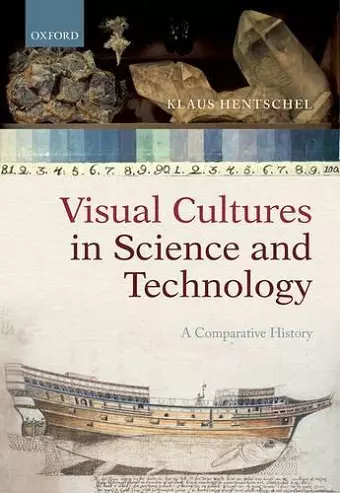Visual Cultures in Science and Technology
A Comparative History
Format:Hardback
Publisher:Oxford University Press
Published:30th Oct '14
Currently unavailable, and unfortunately no date known when it will be back
This hardback is available in another edition too:
- Paperback£41.99(9780198829782)

This book is offers a broad, comparative survey of a booming field within the history of science: the history, generation, use, and function of images in scientific practice. It explores every aspect of visuality in science, arguing for the concept of visual domains. What makes a good scientific image? What cultural baggage is essential to it? Is science indeed defined by its pictures? This book attempts a synthesis. It delves into the rich reservoir of case studies on visual representations in scientific and technological practice that have accumulated over the past couple of decades by historians, sociologists, and philosophers of science. The main aim is thus located on the meta-level. It adopts an integrative view of recurrently noted general features of visual cultures in science and technology, something hitherto unachieved and believed by many to be a mission impossible. By systematic comparison of numerous case studies, the purview broadens away from myopic microanalysis in search of overriding patterns. The many different disciplines and research areas involved encompass mathematics, technology, natural history, medicine, the geosciences, astronomy, chemistry, and physics. The chosen examples span the period from the Renaissance to the late 20th century. The broad range of visual representations in scientific practice is treated, as well as schooling in pattern recognition, design and implementation of visual devices, and a narrowing in on the special role of illustrators and image specialists.
This fine work is a survey of the history, use, and function of the image in the practice of science. ... The book is very readable, amply illustrated, and carefully documented; the biography alone exceeds 80 pages. Highly recommended. * Choice *
a very useful synthesis of the study of the history and historiography of visual representation in the early modern and modern periods up to the late 20th century within the Western tradition * Renzo Baldasso, Centaurus *
The spotlight that Hentschel casts on members of the latter group, a diverse cast of woodcutters, illustrators, illuminators, and other technicians, is a particular strength of the book. * Evan Hepler-Smith, Historical Studies in the Natural Sciences *
a timely but colossal endeavour to take stock of the literature on visual cultures of science ... He has written a work that operates both as a major resource, friendly to those who want to merely dip in and out, and as a major scholarly contribution with a sustained argument about what constitutes visual cultures in science. Indeed, Hentschel must be congratulated on a fine contribution, one that actually gives much-needed shape to the field of visual cultures and the sciences. * Omar W. Nasim, The British Journal for the History of Science *
Hentschel's is a clear and useful book which critically discusses and compares a bulk of historical case studies to reveal general principles within a broad pattern. The book is supplemented with remarkable pictures, which perfectly illustrate the notion of layered visual culture, as well as a rich bibliography and suggestions for further reading. ... Hentschel's book can be recommended to both students and specialized scholars. * Marco Tamborini, Annals of Natural History *
Visual Cultures in Science and Technology is intended to provide a systematic and integrative account of the formation and development of a plurality of visual cultures throughout the history of Western science, technology, and medicine. At the core of its methodology is an exhaustive -- and new -- comparative approach based on a large number of case studies covering a period that extends from the early modern era to the present day. The selection and range of examples is indeed phenomenal. And so are the visual materials and bibliography that support the argument. * José Ramón Marcaida, ISIS *
- Winner of Shortlisted for the 2016 BSHS Pickstone Prize.
ISBN: 9780198717874
Dimensions: 253mm x 182mm x 33mm
Weight: 1228g
512 pages